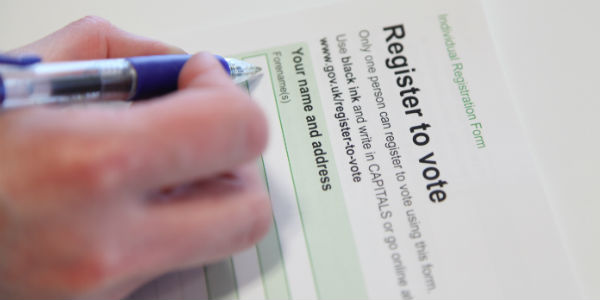Now they’re on a roll: how to get the missing millions onto the electoral register
Individual electoral registration has not been kind to students. Previously, they were automatically enrolled by their universities; now they are not, and many have fallen off the electoral roll as a result. But an amendment passed in the Lords last night would let them register at the same time as they enrolled at university. Toby S James, Lord Chris Rennard and Josh Dell say automatic invitations to register ought to be extended to non-students – as happens when US citizens renew a driving licence – to ensure some of the millions of unregistered people have the right to vote.

Photo: Electoral Commission. All rights reserved, used with permission.
Before the Lords voted against Brexit yesterday in the House of Lords, the government was defeated on another important democratic issue: voter registration. This passed largely without comment by the media (and went unmentioned in the BBC’s Yesterday in Parliament, for example). It is unsurprising that voter registration rarely receives the same level of coverage as Brexit, but it is nonetheless a vital issue. Up to 8 million people were thought to be missing from the electoral register in 2015. Research shows that citizens were turned away from the polls at the Brexit referendum because they were not registered to vote.
Registration levels have been declining for a long time. It was long forecasted that this decline would continue under individual electoral registration (IER). The introduction of online voter registration and voter outreach work from organisations such as Bite the Ballot did much to address this in the run-up to the EU referendum. But now the referendum is past, we should expect the completeness of the register to slide away again.
One group that research predicted would be hardest hit was students. Under the old household electoral registration system, they were automatically enrolled by their university administration. Although data on the number who have fallen off the register is hard to track, we know that young people were especially affected by IER. It was therefore a mistake that the Electoral Administration Act of 2013 did not provide for a suitable student registration to be put in place when the old system of household registration was abolished.
Yesterday, an amendment to the Higher Education and Research Bill was introduced to require universities to offer students the opportunity to register to vote at the point of enrolment or re-registration as a student at their university. A successful example of a scheme like this was piloted at Sheffield University, where student registration rates soared to a quoted 76% of its eligible students registered, compared to 13% at similar-sized institutions. The amendment offers an opportunity to save significant funds too. The head of registration services at Sheffield Council has confirmed that the cost of registering a student with this model is just 12p, rather than £5. Cardiff Council calculates that using this scheme for combining enrolment with electoral registration has saved it some £63,000.
The amendment was passed, against the government, by a majority of 200 to 189.
Beyond students: towards a more inclusive democracy
The principle behind the amendment is a simple and powerful one. Make voter registration easy and convenient and more people will register. If you combine registration with other administrative jobs, such as paying council tax or renewing a driving licence, the paperwork-adverse citizen will be more likely to complete it. It is important that measures therefore go beyond supporting student registration and that the idea is extended to other public services to engage the wider public.
There is a powerful research and international practice to suggest that this works. In the US, a federal Act was passed in the 1990s to expand the number of locations and opportunities whereby eligible citizens could apply to register to vote. In particular, citizens were to be given a voter registration application when they applied for or renewed a driver’s licence (hence it became known as the ‘Motor Voter Act’), or when applying for (or receiving) services at certain other public offices. Nearly one third of registrations are submitted in the US at motor vehicle agencies. Some studies suggest it raised turnout by around 2 percentage points and some have argued that the results could have been even better with improved implementation.
Support for making registration easier dates back to 2014, when a select committee report on Voter Engagement proposed making it automatic. This became the basis of some party manifestos. There is now a growing cross-party consensus about a set of measures that could be used to address the problem of the Missing Millions, with a report on the issue published last year and backed by members of all political parties in Westminster. After all the divisions the Brexit debate has opened up, the effort to build a complete and inclusive democracy is more important than ever before.
This post represents the views of the authors and not those of Democratic Audit.
 Dr. Toby S. James (left) is a Senior Lecturer at the University of East Anglia and Lead Fellow on Electoral Modernisation to the All Party Parliamentary Group on Democratic Participation.
Dr. Toby S. James (left) is a Senior Lecturer at the University of East Anglia and Lead Fellow on Electoral Modernisation to the All Party Parliamentary Group on Democratic Participation.
Lord Chris Rennard is Co-Chair of the All Party Parliamentary Group on Democratic Participation.
Josh Dell is part of the leadership team at Bite The Ballot, focusing on communications and advocacy.





 Democratic Audit's core funding is provided by the Joseph Rowntree Charitable Trust. Additional funding is provided by the London School of Economics.
Democratic Audit's core funding is provided by the Joseph Rowntree Charitable Trust. Additional funding is provided by the London School of Economics.